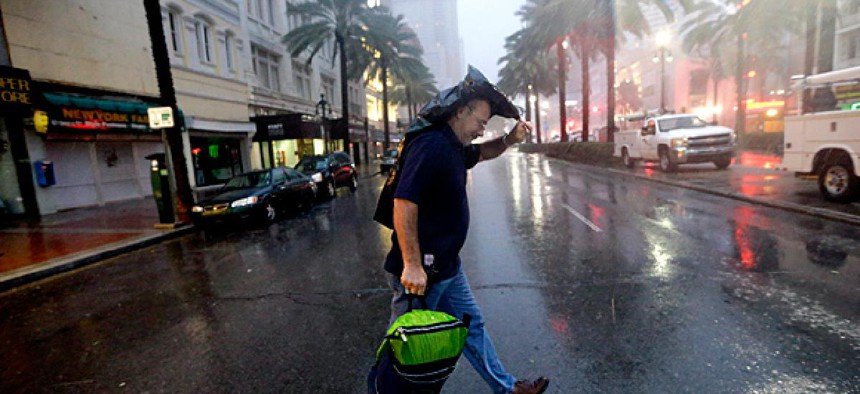
David J. Phillip/AP
Analysis: Why Republicans need to get FEMA right
Americans have come to see the federal government as essential to disaster relief.
Before there was Katrina or Isaac, there was Andrew. In 1992, 20 years ago almost to this very week, the Category 5 hurricane struck Florida. It was then the costliest hurricane in U.S. history, and the federal government’s botched response earned scorn for the Federal Emergency Management Agency, charged with coordinating disaster relief. People stood in endless lines at relief centers. Supplies that could have been ready were not. Then-Sen. Fritz Hollings, a South Carolina Democrat, once called FEMA “the sorriest bunch of bureaucratic jackasses I’ve ever known,” and that week in Florida, it was hard to find many who would disagree.
We won’t know the damage from Isaac for some time, but we do know that the politics of FEMA are treacherous, perhaps especially for Republicans. An agency that gives out free food, water, and housing might not seem to be at the top of the priority list for a party that promotes self-reliance and includes many faithful who consider Ayn Rand to be a life coach.
But tea party or not, Americans have come to see the federal government as essential to disaster relief, and those such as Rep. Ron Paul who have suggested ending that role are true outliers. After all, it was Herbert Hoover who got the federal government into the disaster-relief business. The 1927 Mississippi River flood was a national calamity, and state governors called on Hoover, then Commerce secretary, to coordinate relief. He touted his efforts during his GOP presidential campaign the following year.
But disaster relief has not been a Republican selling point since Michael Brown, the agency’s head during Katrina, became synonymous with failure. There were plenty of others to share the blame, including two Democratic officials at the time, Louisiana Gov. Kathleen Blanco and New Orleans Mayor Ray Nagin. But the criticism of FEMA, including from a bipartisan committee from the then-GOP controlled House of Representatives, skewered the agency.
Every presidency needs to get FEMA right—but especially Republican ones. Fairly or unfairly, the public and the media are going to judge them more harshly than Democrats. Republicans need to make this basic function of government work well. For this, they could take a lesson from the Clinton administration. (This idea doesn’t seem so hard to swallow at a time when Mitt Romney glowingly references Bill Clinton in not one but two campaign ads.)
Although FEMA had been primarily a reactive agency—waiting for requests to come in from disaster-stricken areas and then slowly responding—Clinton’s director, James Lee Witt, used the agency’s dormant powers to mobilize even if states or local jurisdictions didn’t seek aid.
Back in 1992, after Andrew hit, Transportation Secretary Andrew Card, appointed by President Bush to head an impromptu hurricane task force, persuaded Florida’s Democratic governor, the late Lawton Chiles, to accept federal relief after he initially declined. As Daniel Franklin notes in a history of the incident, FEMA could have made the same determination Card did, had it bothered to.
Witt made FEMA proactive, and he also downgraded the agency’s remote if not implausible charge of helping Americans survive a nuclear war.
The good news for Republicans is that FEMA would seem to be an area of government where a President Romney could make his mark. If he’s an efficiency expert and a problem solver, he should be able to take the agency and make it work even better, even though he wasn’t much tested by natural disasters as governor. When Massachusetts dealt with flooding in 2006, Romney dutifully asked for federal aid—although he got knocked for having vetoed a flood-control project in 2004 that might have stemmed some of the damage. There’s no shortage of competent state emergency-management directors he could call on to lead FEMA. This is one job that Mike Leavitt, the former Utah governor and EPA administrator who has been tapped to run Romney’s transition team, shouldn’t wait until the last minute to fill.
NEXT STORY: Data Center Power






